What is general information about the box and 1 defense
Basic definition
The box and 1 defense is a basketball strategy as well as a type of junk defense that utilizes a combination of man to man and zone defense principles to limit an opponent’s potential scoring opportunities.
More specifically, the box and 1 seeks to neutralize the scoring and/or playmaking abilities of the opposing team’s best player with effective on-ball defensive pressure in addition to off-ball defensive support, especially near perimeter areas of the court.
Potential advantages and drawbacks
In terms of a potential advantage, the box and 1 defense could be beneficial against teams with below average perimeter shooting abilities, particularly from three-point range.
On the other hand, one possible drawback of the box and 1 is that it could become vulnerable if the opposing team is able to get the ball into the high post area.
That could lead to a break down, especially in relation to the zone aspects of the overall defense.
In addition to that, the box and 1 may not be a suitable strategy to consider if the opposing team includes more than one scoring threat.
That could present a significant challenge to the defense, especially if that secondary scoring threat possesses an above average jump shot.
Box and 1 defense: Initial formation example
The diagram below showcases an initial formation of the box and 1 defense, particularly when the basketball is at the top behind the three-point line.
It is important to note that on the diagram below as well as subsequent diagrams afterwards, each offensive player is indicated by a number that generally represents one of the standard basketball positions and each defensive player has a correlated number to a similar position that is shown alongside the letter X.
In essence, 1 is the offensive point guard while X1 is the defensive point guard.
2 is the offensive shooting guard while X2 is the defensive shooting guard.
3 is the offensive small forward while X3 is the defensive small forward.
4 is the offensive power forward while X4 is the defensive power forward.
Lastly, 5 is the offensive center while X5 is the defensive center.
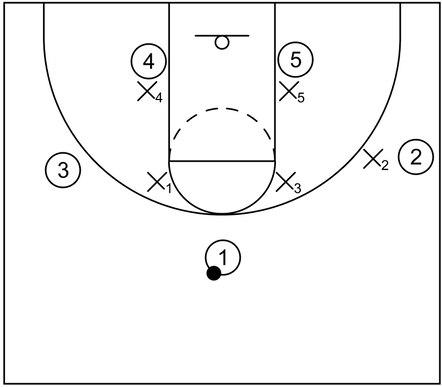
In terms of the initial setup, four players, aligned in the form of a box, are the zone defenders.
On the diagram example, these defenders are denoted as X1, X3, X4, and X5.
These particular defenders will basically cover certain areas of the court instead of guarding against a distinct opposing player.
Also, one additional player typically known as the chaser will perform man to man defense, specifically against the opposing team’s top-tier offensive player, who could be referred to as the target.
On the diagram example, X2 is the chaser and 2 is the target. Therefore, X2 will guard 2 with man to man defense.
In other words, no matter where 2 goes on the court, X2 will chase after them and implement a certain level of defensive pressure.
Additional information to consider
As it relates to offensive production, it would generally be more convenient if the chaser is not the primary scorer on their respective team.
The reason for that is because the chaser could potentially use much energy guarding the opposing team’s best player.
This, in turn, could lead to offensive fatigue, which could hamper the chaser’s ability to score productively and efficiently.
In addition to that, the point guard or shooting guard should normally be designated as the chaser, at least in most cases.
This is generally recommended due to those players’ abilities to use their speed, quickness, and overall stamina to guard the target with great effect.
However, a small forward, particularly a 3-and-D type of player who is mobile enough to move swiftly with consistent effort, could play the role of a chaser as well.
This could be a viable choice in some instances because the small forward usually has longer arms than point guards or shooting guards, which could possibly make it easier to contest field goal attempts taken by the target if necessary.
Furthermore, if a team has two or more players who have the ability to guard the opposing team’s top-tier offensive players, especially at an above average rate, then the coaching staff could switch out chasers periodically.
Switching out defenders on occasion could potentially hinder the target’s scoring productivity as that offensive player would have to adapt to a new or different opponent each time that the change happens.
What are example scenarios of box and 1 defensive rotations
The example diagrams below show a variety of different box and 1 defensive rotations, particularly situations when the ball is located near the top, wing, corner, or high post.
It should also be mentioned that some of the examples are based on knowledge from The Box-and-One Zone Defense by Homer Drew.
Additionally, on each of the diagrams, 2 will typically be the target while X2 is the chaser, unless stated otherwise.
Example 1: Ball at the top, chaser initially guards target near right side wing

This is an example of the box and 1 defense when the ball is at the top, specifically in possession of 1, represented by the black dot.
Notice that X2 is guarding 2 off the ball near the right side wing, which is similar to the initial formation in a previous section.
However, when 2 cuts through to the opposite corner, X2 chases after them, represented by the gray arrow.
Again, as expressed earlier, the chaser follows the target wherever that player goes on the court.
Example 2: Ball near left slot, chaser initially guards target near left side corner
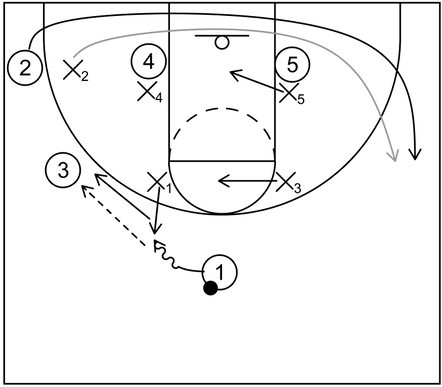
To start this example diagram of the box and 1 defense, 1 dribbles towards the left slot area, represented by the arrow with a wavy line. The slot is also between the top and the wing as an extension of the lane line.
Next, as that dribble action happens, X1 steps out beyond the three-point line to put pressure on the ball.
As that occurs, X3 executes a defensive slide towards the center of the free throw line, also known as the nail area.
Sliding towards the nail is important because it could hinder a cut to the basket from the perimeter areas as well as a flash cut from the low post to the high post area.
Furthermore, X5 also slides over into the lane, primarily to protect the basket and to prevent 4 or 5 from getting easy scoring opportunities near the rim, particularly in the form of layups or dunks.
Afterwards, 3 receives the ball from 1, which results in X1 sliding towards the left side wing to guard the ball as well.
Additionally, notice once again that as 2 cuts through to the right side wing area, X2 chases after them, indicated by the gray arrow.
Example 3: Ball on left side wing, chaser guards target near right side wing
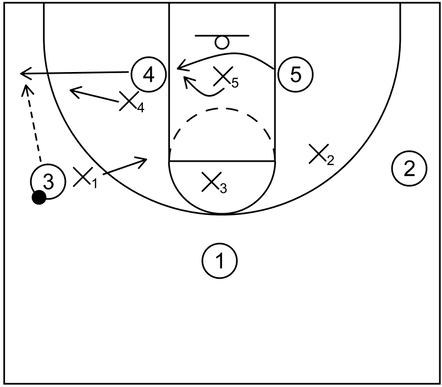
For this example diagram, X1 initially guards the ball near the left side wing while X3 covers the nail area at the top of the zone.
On the back side, X4 can initially cover the general low post area on the left side or possibly front 4 in an attempt to prevent that player from easily receiving the ball from 3.
However, to counter that, 4 pops out to the left side corner and receives the ball from 3. At the same time, 5 cuts across the lane to fill the vacant left side low post area.
As that happens, X1 drops back into the general area near the left side elbow while X4 performs a closeout on the ball to prevent a wide open potential jump shot from 4.
Furthermore, X5 can slide towards 5 as well to be prepared to play on-ball low post defense if 5 were to receive the ball from 4.
The chaser X2 continues to guard the target as usual. Also notice that X2 has sagged off quite a bit and is stationed inside of the three-point line while 2 is located outside of it.
This is mainly a help defense tactic which allows X2 to give off-ball support to X3 if 1 were to cut directly to the basket.
In addition to that, X2 could hinder a cut to the basket by 2 as well if necessary.
Example 4: Ball in left side corner, chaser guards target near right side wing
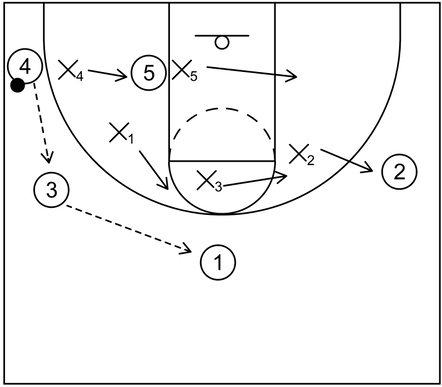
For this example diagram, X4 guards the ball near the left side corner while X1 stands in the gap between 3 and 5.
Also, by standing in the gap, X1 could hinder or prevent potential dribble penetration towards the lane by 4.
Nevertheless though, 3 receives the ball from 4 and after that, 1 receives the ball from 3.
Moreover, as that ball reversal action happens, the zone defenders slide back to their original positions.
At the same time, X2, the chaser, steps out beyond the three-point line to put more defensive pressure on 2.
Example 5: Ball near right slot, chaser initially guards target near right side wing
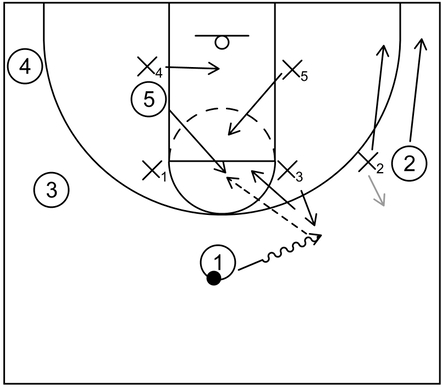
For this box and 1 diagram, the ball is initially back at the top. Also, X2 plays denial defense, indicated by the gray arrow, to prevent 2 from easily receiving the ball.
When that occurs, 1 dribbles toward the right slot area. Additionally, 2 moves to the right side corner while X2 chases after them.
Furthermore, X3 steps above the three-point line to put defensive pressure on 1.
However, X1 does not properly slide towards the nail area, which then gives 5 an opportunity to flash cut to the high post and receive the ball from 1.
Once that happens, the box and 1 defense becomes very vulnerable to breaking down.
Nevertheless, to possibly prevent that from occurring, X3 and X5 should move towards the ball, mainly to initiate a special defensive tactic.
What’s more, X4 should slide into the lane to provide basket protection as well.
Example 6: Ball is in high post, chaser guards target near right side corner
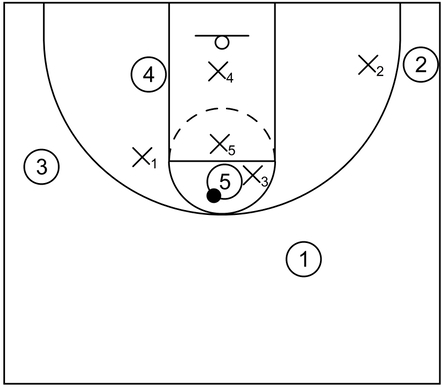
This is an example of a box and 1 diagram when the ball gets into the high post.
Essentially, when that occurs, X3 and X5 should execute the double team tactic to potentially reduce the box and 1 from breaking down, which could then lead to an offensive scoring opportunity.
The main objective here is to influence 5 to pass the ball to a teammate, especially 1 or 3, located near perimeter areas of the court.
X1 continues to guard the area near the left side elbow and should also stay ready to closeout if 3 were to receive the ball from 5.
In addition, X4 continues to cover the basket while X2 stays near 2 anticipating a potential pass in that direction as well.
Example 7: Target has ball on right side wing
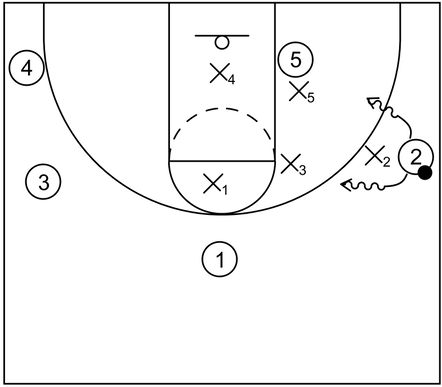
This is a box and 1 defense example when the target has possession of the basketball near the right side wing area.
Essentially, X2 plays standard man to man defense while X1, X3, X4, and X5 cover their respective areas.
Also, notice that if 2 attempts to dribble towards the baseline or towards the lane/high post area, X5 and X3 are able to provide help, which could ultimately hinder that dribble penetration.
Additionally, while executing on-ball defense, it is important to mention that the chaser should not reach at the ball carelessly in an attempt to steal it as that could result in undesirable personal fouls and subsequent team fouls.
Moreover, the chaser should avoid making illegal contact while contesting shot attempts as that could lead to an unwanted shooting foul as well.
Example 8: Target has ball in right side corner
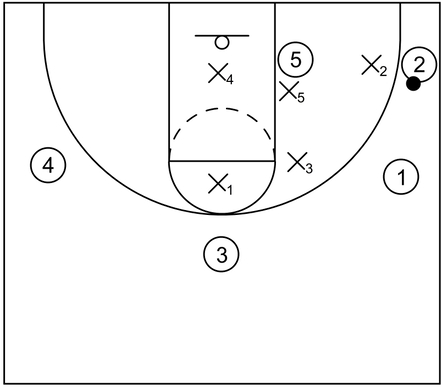
This is another box and 1 example of the target in possession of the basketball. This time, it is located in the right corner.
Once again, X2 guards the ball with an adequate amount of pressure while the other zone defenders cover their respective areas.
What is an example of a box and 1 defense basketball drill
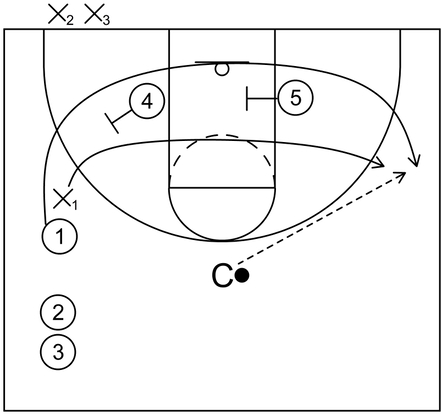
This is an example of a simple basketball drill for the box and 1 defense.
The offensive players 1, 2, and 3 are the targets while defenders X1, X2, and X3 are the chasers.
In addition, the coach at the top, indicated by the letter C, is the passer. However, it should be noted that another player on the team could be the passer instead of the coach.
The first target and chaser combination is 1 and X1 respectively. To begin, 1 executes a baseline cut from the left side wing to the right side wing by way of the screens set by 4 and 5.
X1 cuts across the high side of 1 while also attempting to deflect or steal the pass from the coach.
From that point, if 1 receives the ball and/or scores on the defender, then a point could be given to that player or the offensive team as a whole.
On the other hand, if X1 is able to get a deflection on the ball or X1 successfully steals the pass from the coach, then a point could be given to that defender or the defensive team as a whole.
After that, the next target/chaser combination, which is 2 and X2, participates in the drill.
At the end of the drill, the coaching staff could tally up the points and determine the winners by individual targets/chasers or as the entire offensive/defensive team.
Related: Warriors Box And 1 Zone Defense vs Mavericks – YouTube